Is my tree safe? Recognizing Conditions that Increase the Likelihood of Tree Failure1
Introduction
Trees in our cities and towns consist of the remnants of the area's native forest and planted trees, palms, and shrubs. Urban trees provide shade and beauty in the yards of private homes, parks, and rights-of-way. Additionally, the urban forest as a whole provides a wealth of benefits to neighborhoods and residents through the reduction of energy consumption for home heating and cooling, the removal of pollutants from the air and water, reduction in stormwater flows, increased valuation of private property, increased worker productivity, and a reduction in stress and violent crime, as well as providing recreational opportunities and aesthetic diversity.
While trees make our cities more livable, stresses from the urban environment such as air pollution, damage by vehicles, increased impervious surface, soil compaction, and improper maintenance often reduce the diversity and magnitude of these benefits. In some instances, the combined impact of these stresses on trees may lead to problems that pose an unacceptable safety risk to people and property. It is a landowner's responsibility to ensure that the trees on their property are safe. A key step in reducing the potential for tree-related injury or property damage is learning to identify common tree defects associated with increased risk of failure (Dunster et al. 2013).
This publication highlights seven tree defects that homeowners (and non-professionals in public agencies) may encounter in Florida. All of the defects listed are easily recognizable and may significantly elevate the probability of a tree or tree part failing. Learning to recognize these seven defects can help a property owner decide whether he or she should contract with an International Society of Arboriculture Certified Arborist to further investigate the seriousness of the condition. Arborists experienced in tree risk assessment can aid in this decision process by conducting a professional evaluation that specifies the likelihood of whole or partial tree failure and the consequences of such a failure if nearby targets are struck. Arborists also are qualified to provide advice on tree management to reduce the risk to people and property. Understanding and addressing tree risk can make your property safer and may prolong the life of your trees.
Common Defects
Defects are injuries, abnormal growth patterns, decay, or other conditions that reduce a tree's structural strength. Taking time to look at your tree's crown, main structural branches, trunk, and roots can reveal a great deal about the current health and structural integrity of a tree. If you find any of the following easily recognizable defects in a tree around your home you should consider having the tree examined by a qualified arborist.
Dead Branches
Dead branches may have loose or missing bark and will have dead or absent foliage and buds (Figure 1). If a branch has been dead for some time, it may look coarse or stubby, as smaller twigs gradually break off. The absence or presence of leaves alone should not be used to determine whether a tree has died. A number of Florida trees are deciduous—naturally losing their leaves for a portion of the year.
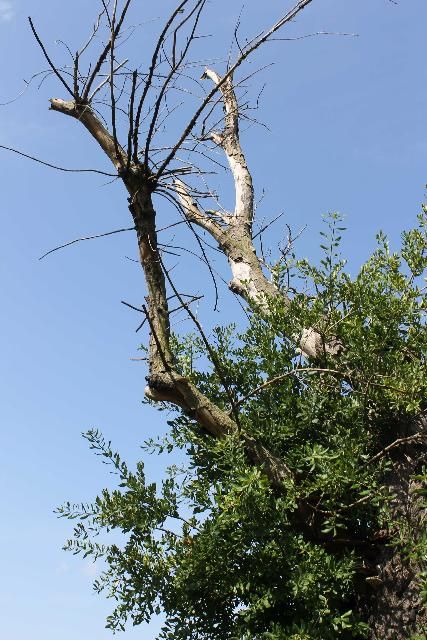
Credit: Gitta Hasing, UF/IFAS
While some decay-resistant tree species will hold on to dead branches for several years, dropping of the dead limb is inevitable. Though dead branches typically break off during storms, they may also drop during less severe weather conditions. In some cases partial failure of dead branches may already have begun (see Broken/Hanging Branches below). Large branches high up in a tree are of greatest concern, since they have the potential to hit a target with higher velocity.
Broken/Hanging Branches
Broken or partially attached branches are already in a state of failure and typically are associated with mechanical damage or advanced states of decay. Dropping of broken and hanging branches is just a matter of time and can occur during calm weather conditions.
Branch Attachment/Codominant Stems
Codominant branches are limbs or stems of similar size that originate from the same point (Figure 2). Their presence increases the likelihood of branch failure in strong storms and hurricanes (Duryea and Kampf 2014). The risk associated with codominant stems increases if the stems are of similar diameter. Additionally, the risk associated with codominant stems or branches is influenced by the angle of attachment. Narrow branch unions that make a sharp V-shape often have included bark (i.e., bark pressed between the two growing stems) and are considered more likely to fail than a branch union that makes a smooth U-shape. The presence of included bark significantly weakens the junction of co-dominant stems. The risk associated with poorly or codominantly attached branches often can be partially mitigated through corrective pruning or the installation of a cable system by an experienced arborist.
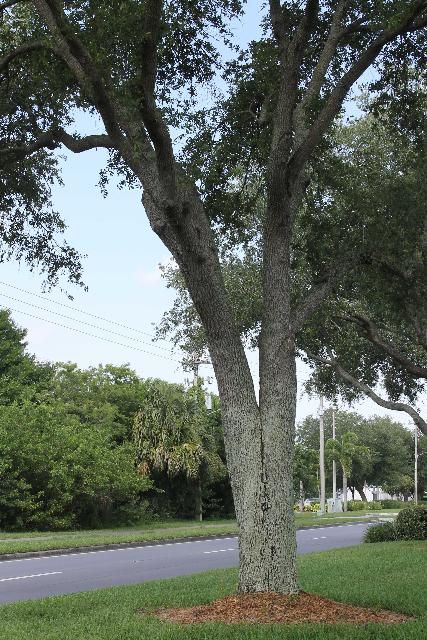
Credit: Gitta Hasing, UF/IFAS
Decay
Wood decay is the breakdown of wood by micro-organisms or extreme environmental exposure. Most tree decay is caused by fungi that feed on the various components of wood (e.g., cellulose, hemicellulose, or lignin). Decay can affect any portion of a tree and can greatly reduce the structural strength of the parts afflicted. Wood decay can be difficult to detect and, once detected, it can be even harder to assess its significance or extent into the tree. Some easily recognizable visual signs of decay are the presence of conks and other fungal fruiting bodies (Figure 3), cavities (see section below), carpenter ants, and animal nesting holes. Once these visual indicators are confirmed, arborists can conduct more advanced tests to assess the location and extent of the decay in order to determine what risk-management actions are most appropriate.

Credit: Gitta Hasing, UF/IFAS
Cavities
Cavities are often sites of past injuries or pruning cuts and are a point of entry for decay fungi (Figure 4). The original cause of the cavity, its current age, and its condition/location on the tree can be used by an arborist to determine the extent of internal decay and appropriate management actions needed to reduce the risk of whole or partial tree collapse. When initially examining a cavity, be careful and check first to see if it is occupied by wildlife or insects.
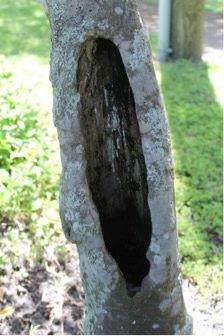
Credit: Gitta Hasing, UF/IFAS
Leans
Trees can develop leans for a number of reasons. Often a lean forms over time as a tree grows away from an object (e.g., a structure or neighboring tree) in search of sunlight. Leaning trees may indicate structural issues with roots, so roots also should be examined. Leaning trees on steep slopes and/or saturated soils have an increased likelihood of failure. However, if a tree is able to produce additional reaction wood to account for this imbalance, the risk associated with this defect can be significantly reduced. In contrast, leans that have formed relatively rapidly (e.g., after a severe storm) are an indication of partial root failure and require immediate attention (Figure 5).

Credit: Gitta Hasing, UF/IFAS
Several indicators can be used to determine whether or not a leaning tree falls into this latter, more severe scenario. Trees with less severe, longer-persisting leans will have enlarged lower trunks (compression wood) to compensate for their unbalanced growth. Additionally, branches with full sun exposure will sweep upward over time to maximize light capture. Trees that continue to increase their lean angle over a short period of time or begin to show signs of soil upheaving should be considered high risk and inspected immediately by an arborist.
Root Problems
Main support roots provide the anchorage needed to hold a tree upright. In addition, fine roots absorb the water and nutrients needed to maintain plant health. Defects in a tree's root system are hard to identify, as they may be hidden by soil or mulch. However, there are a few visual indicators that can highlight potential problems belowground. Examples include a gradual loss, dieback, or thinning of the crown; cavities or swelling in the root collar; fungal conks or mushrooms around the base of the tree (Figure 6); and visibly pruned or broken root stubs at the soil surface. If it appears that main support roots are dead, decayed, or missing, the tree should be further inspected by an arborist to determine if the tree poses a significant risk of collapse during a strong wind storm.
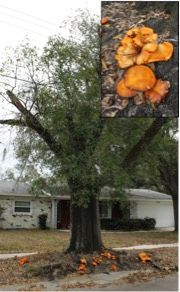
Credit: Gitta Hasing, UF/IFAS
Another common root problem is a buried root system caused by deep planting or increases in soil grade during construction. This condition can lead to root dieback or an increased likelihood of root disease. Most trees should have a well-defined root flare that is at least partially visible above ground. Roots may grow upward toward the surface where soil oxygen and moisture levels are more favorable. In doing so, they may partially circle and eventually girdle the lower trunk of a tree (Figure 7). Circling or girdling roots can make the tree unstable by reducing the overall extent of the root area. Girdling roots can cause stem compression, leading to dieback in the crown and causing decay or structural weakness at the base of a tree.
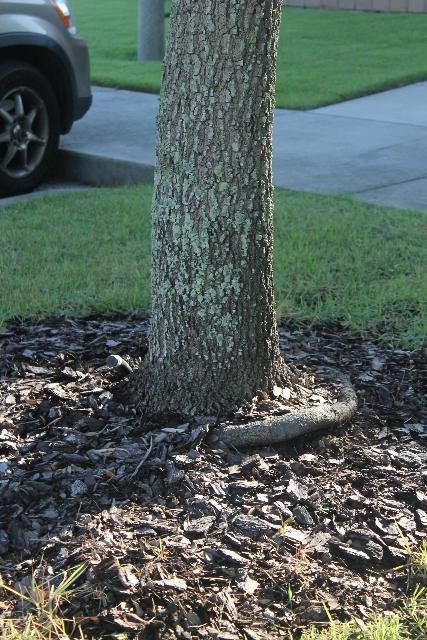
Credit: Gitta Hasing, UF/IFAS
Time to hire an arborist?
One of the most difficult aspects of tree risk assessment is rating the likelihood of failure. There are no definitive rules or benchmarks that clearly separate sound and unsound trees. Similarly, there are no fix-all corrective measures that can be applied to all possible defects and situations. Each defect may require a different action based on the extent of the condition, its location, the tree species, etc. Arborists with experience in tree risk assessment can factor in species-related failure profiles, site factors of concern, and signs and symptoms of tree stress or structural weakness when conducting a tree risk assessment.
Certified arborists are trained individuals who understand a base-level knowledge of trees and their care. With their combined work experience and demonstrated competencies, certified arborists can help you determine if something is not "normal" or is cause for concern for a given tree. As part of an inspection, a certified arborist can offer recommendations for corrective actions to reduce risk and improve tree condition. Depending on the type and extent of the defect present, strategies for reducing risk could be as simple as moving a potential target (bench) or removal of the defective part. In some instances, tree removal may be the only way to effectively mitigate tree risk.
References
Dunster, J. A., E. T. Smiley, N. Matheny, and S. Lilly. 2013. Tree Risk Assessment Manual. Champaign, IL: International Society of Arboriculture.
Duryea, M, and E. Kampf. 2014. Wind and Trees: Lesson Learned from Hurricanes. FOR-118. Gainesville: University of Florida Institute of Food and Agricultural Sciences. https://edis.ifas.ufl.edu/pdffiles/FR/FR17300.pdf
Additional Resources
Gilman, E. F. and A. Bisson. 2007. Developing a Preventive Pruning Program in Your Community: Mature Trees. ENH-1063. Gainesville: University of Florida Institute of Food and Agricultural Sciences. http://hort.ifas.ufl.edu/woody/documents/ch_13_mw06.pdf
Gilman, E. F. and A. Bisson. 2007. Developing a Preventive Pruning Program: Young Trees. ENH-1062. Gainesville: University of Florida Institute of Food and Agricultural Sciences. https://edis.ifas.ufl.edu/ep315
Gilman, E. F., M. L. Duryea, E. Kampf, T. J. Partin, A. Delgado, and C. J. Lehtola. 2012. Assessing Damage and Restoring Trees After a Hurricane. ENH-1036. Gainesville: University of Florida Institute of Food and Agricultural Sciences. https://edis.ifas.ufl.edu/ep291
Kampf, E., A. Delgado, and M. L. Duryea. 2007. Get the Right Tree Care Professional. FOR-116. Gainesville: University of Florida Institute of Food and Agricultural Sciences. http://hort.ifas.ufl.edu/woody/documents/FR171.pdf
Kampf, E., M. L. Duryea, E. F. Gilman, and A. Delgado. 2007. Assessing Hurricane-Damaged Trees and Deciding What to do. FOR-117. Gainesville: University of Florida Institute of Food and Agricultural Sciences. http://hort.ifas.ufl.edu/woody/documents/FR172.pdf


